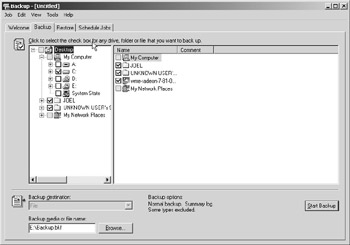Saving Data
|
| < Day Day Up > |
|
Anyone who has important data is advised to back it up regularly. Few of us, however, do so. However, if you have an indication that a drive is about to fail, you might be able to save the data before it does. There are various ways to do this. First, you could copy the data directly. You can install the replacement hard drive into a separate computer on its own channel and transfer the data over a network, or barring that, you could install the replacement hard drive into the same computer on the other channel. Disconnect an optical drive if you have to. The XCOPY command is particularly good for this.
XCOPY
While you could manually transfer data in Windows, the XCOPY command gives you the advantage of certain options that streamline the process. Using the following switches when copying from the C drive to the E drive causes the system to copy hidden and system files, and continue copying even if some files are bad, among other benefits:
XCOPY C: E: /E /V /C /I /F /H
For more information, see the description of XCOPY in Appendix C, "Command-Line Tutorial." You can also open the command prompt and type XCOPY /?. This will provide the command's syntax and list the switches.
Another way to copy blocks of data is by using software such as Drive Copy™ or Drive Image® from PowerQuest®(powerquest.com). These programs have to be installed, but they work much faster than XCOPY.
Backup Programs
There are also backup programs that take all the data to be backed up and create a single highly compressed file. These programs provide a way to back up and restore data, including OSs and programs, exactly the way they were. Early Windows Backup programs could store the backup only on the local drive, floppies, or on a network drive, although the backup file can always be moved to another drive once the backup is complete. The most common backup program is Backup Utility for Windows, better known as Windows Backup, available in Start > Programs (All Programs in XP) > Accessories > System Tools. The interface for Windows Backup is simple (see Figure 6.11). Just follow the wizard.

Figure 6.11: Windows Backup
There are many third-party backup programs on the market, most of which offer more features than Windows Backup does.
Hard Drive Crash
If you have a hard drive that has absolutely ceased to work no matter what steps you have taken to restore it, it has probably crashed. To recover the data, your only option might be to send the drive to a recovery company such as Ontrack (ontrack.com). This is an expensive operation, so it is done mainly when the data is critically important.
File and Settings Transfer Wizard
Introduced with Windows XP, the File and Settings Transfer Wizard allows you to set up a new computer running Windows XP as close as possible to the old one running Windows versions 95 through 2000, including NT 4.0. Available in Start > Programs (All Programs in XP) > Accessories > System Tools, this wizard is easy to follow. Early versions have been troublesome, however. To correct any problems, make sure to install Service Pack 1 or later on Windows XP before proceeding.
|
| < Day Day Up > |
|
EAN: 2147483647
Pages: 175